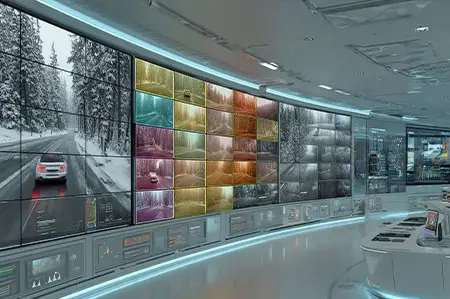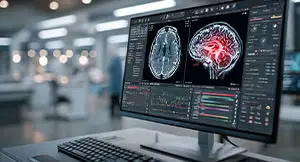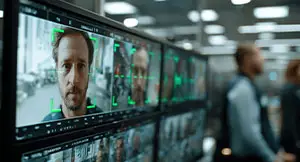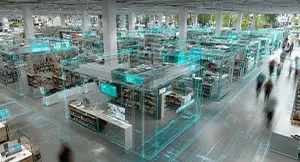Video Annotation Services
The SMART engine for your Video annotation needs.
For our video annotation services, annotating every frame, every moment is our credo. We are using the best annotation tools along with vetted in-house video annotators from our own delivery centers in Bulgaria, Egypt, Madagascar and Philippines to serve you with accuracy, scalability and cost efficient solution.
Oworkers > Data Annotation Services > Video Annotation Services
The different types of video annotation
What are Video Annotation Services?
Video annotation services are essential for developing AI systems that understand animated visual content. These services, often delivered through outsourcing, involve the methodical labeling and tagging of video footage to create structured datasets for machine learning.
Organizations often choose to outsource to companies specializing in video annotation to ensure scalability, efficiency, and access to specialized expertise. This approach extends the capability of AI systems across language barriers, enabling them to comprehend content regardless of the language spoken or displayed in videos.


Bounding Box Annotation
Precisely locate your target objects with our expert video annotation services.
We utilize bounding boxes for accurate segmentation in diverse applications such as autonomous driving and food system optimization. Bounding boxes are ideal for object tracking and detection.
- Achieve precise placement with a simple two-click crosshair system.
- Employ state tracking to manage occlusion, truncation, and overlapping objects.
- Establish custom classes, multiple attributes per instance, and hierarchical relationships.
- Enhance object tracking efficiency and quality with ML Assist.
- Leverage ML-assisted or linear interpolation for seamless between-frame annotation.

Keypoint & Point
Keypoint annotation is a video technique used by our team to precisely locate and orient landmarks within video footage. This method excels at tracking motion, detecting facial landmarks, and recognizing hand gestures by following the movement of specific points on an object.
- Customize keypoint shapes (skeletons, hands, eyes) in a repeatable manner for consistent annotation.
- Mark significant features using point annotations.
- Benefit from support for custom classes, multiple attributes per instance, and hierarchical relationships.
- Leverage linear interpolation for smoother tracking between frames.

Polygon Annotation
Our video annotation services utilize polygons to enhance the accuracy of object detection algorithms. This method is ideal for applications requiring precise boundary definitions, such as vehicle detection and crop identification.
- ML-assisted auto-annotation for polygons
- Grouping and layering of similar objects
- Quick editing tools for point manipulation
- Customizable classes, multiple attributes per instance, and hierarchical relationships
- Linear interpolation between frames

3D Cuboid
Accurately determine the depth and height of objects for applications such as vehicle and pedestrian recognition, robot navigation, interior design placement etc…
- Utilize 2D and 3D cuboids for diverse applications.
- Achieve highly precise 2D cuboids with just three clicks using our multi-click technology.
- Benefit from support for custom classes, multiple attributes per instance, and hierarchical relationships.
- Leverage linear interpolation between frames.

2D Video Annotation with Lines and Arrows
Enhance object tracking and scene understanding in videos using precise lines and arrows to highlight key features. Ideal for analyzing:
- Lane markings and traffic flow
- Identification of urban structures
- Clearly define object edges with line outlines.
- Emphasize directional cues using arrows.
- Benefit from support for custom classes, multiple attributes per instance, and hierarchical relationships.
- Leverage linear interpolation for smooth transitions between frames.
Object Tracking for Video
Our advanced object tracking annotation services enable precise monitoring and identification of moving objects throughout video sequences. This sophisticated technique involves following specific objects frame by frame, maintaining consistent identification and spatial coordinates across the entire video duration. Our expert annotators utilize cutting-edge tools and methodologies to ensure accurate tracking even in challenging scenarios with occlusions, lighting changes, and complex movements.
- Multi-Object Tracking: Simultaneous tracking of multiple objects with unique ID assignment for each tracked entity
- Temporal Consistency: Maintains object identity across frames with advanced interpolation algorithms
- Occlusion Handling: Robust tracking capabilities even when objects are partially or temporarily hidden
- Real-time Processing: Optimized workflows for efficient annotation of long video sequences
- Trajectory Analysis: Complete motion path documentation with velocity and direction metadata
- Cross-Camera Tracking: Advanced tracking across multiple camera views and perspectives
- Automated Interpolation: Smart frame interpolation to reduce manual annotation workload
- Quality Assurance: Multi-level validation process ensuring 99.5% tracking accuracy

Semantic Annotation for Video
Transform your video content into rich, semantically meaningful datasets with our comprehensive semantic annotation services. Our approach goes beyond simple object detection to provide deep contextual understanding of video scenes, including object relationships, environmental context, and behavioral patterns. Each pixel and region is carefully labeled with semantic meaning, creating detailed maps that enable advanced AI applications in autonomous systems, surveillance, and content analysis.
- Pixel-Level Segmentation: Precise semantic labeling of every pixel in video frames for maximum detail
- Scene Understanding: Comprehensive analysis of environmental context and object relationships
- Temporal Semantic Consistency: Maintains semantic coherence across video sequences
- Multi-Class Labeling: Support for complex taxonomies with hundreds of semantic categories
- Hierarchical Annotation: Nested semantic structures from general to specific classifications
- Action Recognition: Semantic labeling of activities, behaviors, and temporal events
- Contextual Metadata: Rich descriptive information including scene type, lighting conditions, and spatial relationships
- Custom Ontologies: Flexible semantic frameworks tailored to specific industry requirements

Multilingual Video ANNOTATION SERVICES
Multilingual video annotation services presents unique challenges beyond standard annotation. Videos with multiple languages require annotators with specific linguistic abilities and cultural understanding. For global AI systems, multilingual video annotation ensures models can interpret content across languages, including spoken dialogue, text in various scripts, and culturally specific visual elements.
Key Applications of
Video Annotation SERVICES
Video annotation involves labeling or tagging video clips to train machine learning models to detect and identify objects. This process is performed on a frame-by-frame basis to ensure accuracy. Here are some of the key applications:

Autonomous vehicles
Self-driving technology relies heavily on video annotation services to teach vehicles how to “see” the road. Annotated video data helps these systems identify traffic signs, signals, pedestrians, and other vehicles in real-time.
The multilingual aspect becomes crucial when autonomous vehicles operate in different countries where traffic signs and road markings vary by language and design.

Media Analysis & Entertainment
The entertainment industry uses video annotation services for content analysis, recommendation systems, and viewer experience enhancement.
Multilingual capabilities allow streaming platforms to analyze international content, understanding key moments and themes regardless of the original language. Video annotation takes these features to the next level.

Content
Moderation & Safety
Social media platforms and content-sharing sites use AI-powered moderation systems to identify inappropriate or harmful content across millions of videos uploaded daily.
These systems depend on extensive video annotation services to recognize problematic content regardless of the language spoken or text displayed. A reliable video annotation company ensures these systems can effectively moderate content at scale.
Object Detection and Tracking
This is one of the most common applications, where annotators draw bounding boxes or other shapes around objects to help AI models identify and track them in real-time. This is crucial for applications like autonomous vehicles, which need to track other cars, pedestrians, and traffic signs.

Pose Estimation and Action Recognition
By annotating key points on a human body, AI models can learn to recognize different poses, gestures, and actions. This has applications in sports analytics, to analyze athlete performance, and in healthcare, for physical therapy and rehabilitation.

Semantic Segmentation
This technique involves classifying each pixel in a video frame to a specific category, providing a highly detailed understanding of the scene. It is used in applications like medical imaging, to identify tumors or other abnormalities, and in autonomous driving, to distinguish between the road, sidewalks, and other elements.

Facial Recognition
Video annotation is used to train AI models to recognize faces, which has applications in security and surveillance, as well as in social media, for tagging friends in photos and videos.

Scene Understanding
By annotating different elements in a scene, AI models can learn to understand the context of a video. This is used in applications like content moderation, to identify and flag inappropriate content, and in retail, to analyze customer behavior
How to Choose the Right
Video Annotation Company ?
When selecting a video annotation company for your projects, several factors should influence your decision. The ideal video annotation company combines ethic behaviour , technical expertise with linguistic capabilities and robust security measures.

Quality Assurance & Accuracy Standards
The value of video annotation services depends on accuracy, as even small errors can significantly impact AI model performance. We implement multi-layer QA (quality assurance) processes, including reviewer validation systems and continuous performance monitoring by dedicated QA team and Project managers.
Multilingual Capabilities & Cultural Understanding
For truly effective multilingual video annotation services, providers must offer more than basic translation capabilities. Ideal partners employ native speakers with cultural familiarity across all target languages to ensure annotations capture linguistic nuances and cultural context properly.


Security & Data Protection
Video content often contains sensitive information requiring robust security measures. When choosing a video annotation company, carefully assess their security protocols, including physical security at annotation facilities, digital protection measures, and compliance with international standards like ISO 27001 and GDPR.
ETHICAL
We employ only employees with full package (social security) and We have strict code of ethics and code of conduct.
Unlike competitors who rely on freelancers or crowdsourcers , we employ full-time, IN-HOUSE professionally trained annotators with comprehensive benefits. This approach results in low staff turnover rate (1.7% compared to industry average of 16.8%), ensuring consistent quality and knowledge retention.

Industries & Sectors
for video annotations
While facial recognition represent the most visible application of video annotation services, the technology’s reach extends across numerous industries.

Geospatial and Urban Planning
his sector uses video annotation to analyze aerial and satellite imagery for applications like urban planning, environmental monitoring, and disaster response.

Agriculture
The agriculture industry uses video annotation to monitor crop health, detect pests and diseases, and optimize irrigation, leading to increased yields and reduced costs.

Autonomous Vehicles
The automotive industry is a major consumer of video annotation services, using them to train self-driving cars to navigate roads safely.

Robotics and Manufacturing
In manufacturing, video annotation is used to train robots to perform tasks like quality control and assembly, improving efficiency and safety.

Retail and E-commerce
Retailers use video annotation to analyze customer behavior in stores, optimize product placement and stocks in shelves and prevent theft. In e-commerce, it is used to enhance product recommendations and improve the overall customer experience.

Security and Surveillance
Video annotation is essential for training security cameras to detect threats, identify suspicious behavior, and recognize faces.

Healthcare
In the medical field, video annotation is used to analyze medical images and videos, helping doctors to diagnose diseases more accurately and to plan surgeries.
FAQ
What is the difference between video annotation and image annotation?
How does multilingual expertise impact video annotation quality?
What industries benefit most from professional video annotation services?
How long does professional video annotation typically take?
While both video and image annotation services involve labeling visual content, video annotation addresses the additional dimension of time and movement.
Unlike static image annotation, video annotation must maintain consistency across frames while tracking objects as they move, change appearance, or interact.
Video annotation also often incorporates temporal elements like action recognition and event sequencing that aren’t present in image annotation.
Multilingual expertise dramatically affects annotation quality, particularly for content featuring multiple languages.
Annotators with native-level language skills can properly interpret spoken dialogue, on-screen text, and culturally specific visual elements that might confuse non-native speakers.
This expertise ensures that all relevant information is accurately captured, regardless of language.
Several industries derive substantial value from professional video annotation services:
- Autonomous vehicle manufacturers rely on annotated video for navigation systems
- Healthcare organizations use it for medical imaging analysis and surgical procedure recognition
- Security firms depend on annotated video for surveillance and threat detection
- Media companies leverage it for content categorization and recommendation systems
- E-commerce platforms use video annotation for visual search capabilities
The timeframe varies based on video length, annotation complexity, accuracy requirements, and language needs. Working with an experienced provider like OWorkers can significantly reduce turnaround times through optimized workflows, specialized tools, and access to skilled multilingual annotators across multiple time zones.
Start Your AI Journey with video Annotation EXPERTS
Contact us today to discover how our ethical, secure, and cost-effective video annotation services can accelerate your AI development journey.

